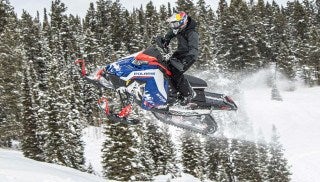2008 Polaris Switchback 700

Polaris goes ‘Raw’ with new switchback
If motorcycles can be ‘naked,’ why can’t Polaris Switchbacks be ‘Raw’? In general terms, naked and raw really mean getting down to basics.
Engine Type:Horizontal In-line
Cylinders:2
Engine Stroke:2-Stroke
Valve Configuration:Reed Valve
Displacement:700 / 42.7
Starter:Pull
Turbocharged:No
View Full SpecNaked bikes are models with any extraneous fairings and ‘cutesy’ details left off. It’s the same for Raw on select Polaris snowmobiles. In both cases, less weight generally means improved power to weight, which leads to improvements in acceleration and other benefits.
Ironically, you might think a Raw Polaris 700 Dragon Switchback would be lighter than its slightly less expensive and definitely lesser equipped standard 700 Switchback brethren. The Dragon version is actually four pounds heavier and about US$600 more expensive. Still, the value lies with the Dragon.
Hybrid Chassis
 The RAW chassis is lighter and stiffer than previous Polaris extended chassis designs.
The RAW chassis is lighter and stiffer than previous Polaris extended chassis designs.
With the radiator gone, the engine still demands ample cooling. Reaching back into its bag of tricks from the mid-1970s and the original liquid-cooled TX-L, Polaris reintroduces full-length cooling extrusions, which mount around the chassis perimeter. Not to worry, this concept was proven tough, reliable and darn near indestructible in years of Polaris cross-country racing dominance. By using the outer edges of the chassis to mount the extrusions instead of running them under the seat helps eliminate under-tunnel ice build-up.
There is a third trick employed by Polaris chassis engineers. Large snow evacuation holes (as Polaris calls them) not only reduce underfoot snow build up, but since holes require removing material to make them… well, there is weight reduction in the chassis.
When you look at the Switchbacks, you’ll note that the seat sits naked atop the tunnel. No extraneous rear panels or such. Of course, there is an optional seat bag that is specifically designed for that area. We’d certainly consider it. You can carry items like a tow strap or off-trail basics when boondocking. The Dragon Switchback is an ideal off-trail runner. If you own one, break away and enjoy it.
Boondocking Segment
Although Polaris pretty much invented the boondocking segment, ironically the company was about to get out of the segment just as Ski-Doo entered the category with its Renegade series. With Ski-Doo’s success in the boondocking segment, Polaris reconsidered and reinvigorated its hybrid models. The company’s best efforts are its current models.
With weights claimed to be just less than 500 pounds, the Switchback 700 models have ample performance from the 140-horsepower twin. This liquid-cooled, Polaris-engineered and built motor delivers the same power as the company’s 4stroke turbo, but has nearly 100 less pounds to haul around. The Liberty twin is exactly what you want off-trail. With its Cleanfire injection system and digital electronics, this sled reacts instantly to throttle inputs and won’t suffer a momentary stutter like a carbureted engine. When breaking powder off trail, you want power to come on exactly when you ask for it. The Cleanfire 700 delivers. Plus, it has the top end to blast through miles of fresh snow on a long Minnesota lake surface.
Polaris-Proven Drive
 The Cleanfire injection is quick responding and precise—attributes you want in an off-trail sled.
The Cleanfire injection is quick responding and precise—attributes you want in an off-trail sled.
The Ripsaw spins around an updated version of Polaris’ parallel rail skidframe. Where the base Switchback uses Ryde FX shocks on the front and rear arms, the Dragon version features a high-pressure gas shock with an internal floating piston on the front suspension arm. You’ll find a compression adjustable RydeFX shock with remote reservoir on the rear arm. Polaris engineers anticipate that Dragon owners will be more aggressive and equipped the Dragon Switchback with shocks that can handle serious boonie basing.
Up front, the Polaris IQ suspension uses all new spindles that not only reduce steering effort by a claimed 15%, but also weigh a pound less per pair.
Cost Justified
 Dressed in an aggressive red with ‘Dragon’ graphics, the Dragon Switchback stands out.
Dressed in an aggressive red with ‘Dragon’ graphics, the Dragon Switchback stands out.
We like the use of what Polaris calls its Freestyle seat. Sloped toward the fuel tank, the seat lets you pop up quickly to react to the terrain, critical when riding off-trail. The runningboards are wide to fit a large boot and the seat is short enough to stay out of the way when hopping from side to side to maneuver through deep snow or around those blow outs that you find at the base of evergreens.
We also like the shape of the hood. Being cutaway near the centralized headlight cowling, you can keep your ski tips in sight. It might not seem like a big deal, but we find it comforting. Maybe that’s because we were poor deep snow skiers and when we lost our ski tips, it usually meant we were about to fall. Let’s just say we like to see our skis. The Polaris Switchback allows that.
For Adventurous Riders
Compared to the original Indy Switchbacks, the IQ versions look bigger, but not as long as the RMK 155 series. Think of the Switchback as Dragons for the adventurous. You won’t have the same top speed as the shorter tracked Dragon riders, but you’ll be able to get into (and out of) situations they can’t.
For 2008 Polaris comes at you with a very nice 700 twin and 140 horses. Think of the Dragon Switchback 700 as Polaris’ ultimate all-weather weapon. It rides and handles well on groomed trails, but excels where the trail ends and adventure begins.
Related Reading
2008 Polaris Dragon 600
A sled that embraces the real Polaris heritage








 Your Privacy Choices
Your Privacy Choices